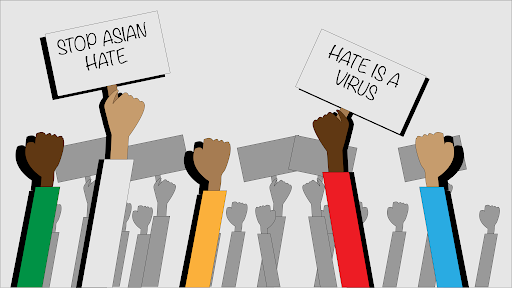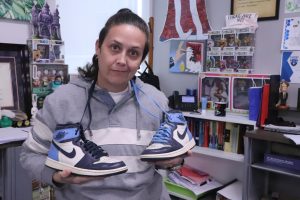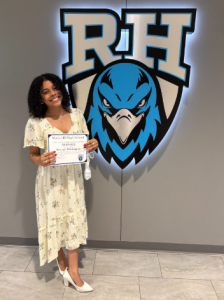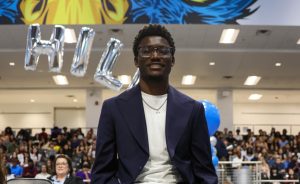The Model Minority
The real cost of being the world’s academic model

Senior David Busbee created a portrayal of an equality protest where people hold up signs. Honors English teacher Jennifer Cheng says “I don’t know any Asian person who hasn’t experienced discrimination of some kind.” Hill Top Times reporter Jade Kratochvil hopes to bring light to the extent and impact that racism has had against the Asian community.
November 1, 2021
Following the COVID-19 pandemic, fear and stereotypes have brought to light the preexisting issue of Anti-Asian hate in the United States and around the world.
Stereotypes
Uneducated and ill-conceived assumptions have an extensive history within the Asian-American community. One of these confinements is the term ‘model minority.’ Although it may sound like a positive expression, this term can be hurtful. A model minority, by definition, is a minority demographic of particularly successful people compared to other minority groups.
“[The idea of a model minority] has been perpetuated by stereotypes for years and years. While it’s supposed to be the best stereotype, it’s really not. It can still hurt.” Honors English teacher Jennifer Cheng said, addressing the issue.
One way the term model minority manifests itself is in the expectation of educational accomplishments. The media depicts Asians as geniuses and honorable students, and while this in and of itself is not bad, the expectation to uphold this ideal can be stifling. This assumption transfers to several aspects of life, but it is most apparent in the American education system.
“The idea of Asians having to be smart is a standard in America,” junior Catalina Zuo said.
While these expectations are not limited to these subjects, Asian-Americans are specifically expected to excel in math and science, which are perceived as some of the hardest subjects to succeed academically.
Despite these standards being a norm in America, several Asian countries don’t even have these expectations. “In China, they’ve always [believed] women shouldn’t go into STEM [because] it’s too hard for girls and therefore shouldn’t be applied to it,” Zuo said.
Not every Asian is good at math and science. The pressure to be smart and make good grades can create a stressful environment in schools for this demographic of students.
“My classmates always come to me [for homework] even though I would be just as confused. I’m not that good at math,” RHHS junior Kaavya Sethi said.
Most students find it hard enough to succeed with their own course load, and when a stereotype tells one’s peers that they can ‘help’ with their homework because they’re ‘supposed’ to be smart, the pressure can get too much.
“There’s a reason I’m an English teacher. I’m not good at math. I definitely don’t meet that Asian stereotype,” Cheng said, clarifying any confusion about her personal experience of perpetuating that stereotype. The effect of stereotypes about minorities is widespread and takes a long time to undo. Largely due to lack of representation, cliches are broadcasted loudly, while the silence surrounding the issue is deafening.
“The people that fit this model get the most attention. It doesn’t apply to everyone,” Zuo said.
Sometimes parents of Asian students are the ones pushing their kids to do better in school. Because of their inherent challenge ascribed to being a minority, Asian Americans often feel the need to work harder.
“Growing up Asian, we all felt the pressure,” Cheng said, her childhood reflecting this sentiment.
Pressure to be someone different–someone better–comes not only from parents but peers, public figures and media, too. “A lot of people follow the media to be able to confirm their own beliefs,” Zuo said.
Mob mentality comes to play in situations like these. If the majority of people believe one way, it’s hard not to believe that it’s the truth. Following the crowd can cloud one’s judgment and leave those subjected to these perceptions in the storm’s eye.
“People are really influenced by stereotypes. And sometimes [people] don’t think practically,” Sethi said, blaming a lack of acceptance and ignorance for this problem.
The designation model minority, alongside other stereotypes, downplay the negative effects of Anti-Asian racism. Cheng admits she hears comments from her students annually that are very clearly microaggressions. One of the recurring questions asked is if her favorite animal is a panda, which is the national animal of China. “No, pandas are not my favorite animal,” Cheng said.
Discrimination
Racial discrimination includes everything from quiet comments to brutality. It might not always be evident to the offender that their behavior is hurtful.
“They don’t have to be direct aggressions. They can be microaggressions,” Seth said.
To an outsider, discrimination may seem small or unimportant. This is why there are so few groups that talk about Asian hate, as it doesn’t always raise red flags.
“I don’t know [an] Asian person who hasn’t experienced discrimination of some kind,” Cheng said, “It happens so often you brush it off.”
Discrimination looks different to everyone. While it is all around Cheng, some Asian Americans don’t encounter it at all.
“I’m one of the lucky ones. I haven’t experienced direct discrimination; at least I don’t think I have,” Zuo said.
“Personally,” Sethi said, “I’m South Asian, and people tend to mock [our] accents.” This is a racial prejudice especially common among teenagers and is not always seen as racist because other dialects are also impersonated. The difference? British and French accents are beautiful and sophisticated, while Indian and Chinese accents are humorous and dumb.
Sethi recalls discrimination when moving back to America after living in India for a few years, though no longer a concern. She had trouble pronouncing some words and would get frustrated when her peers couldn’t understand her. Reportedly, in elementary school, her peers mocked her.
“They just made me even more frustrated.” Sethi continues.
Because Asia is the presumed origin of COVID-19, Asian Americans are targeted more than ever. The rate of hate crimes has steeply increased since the virus spread across the world.
When asked exactly how much COVID-19 has influenced Anti-Asian hate, Cheng said, “A lot. A lot.”
She points out that Asian-owned businesses are suffering as a result of racism. People are afraid of the virus, so they stay away because “[Asians] are it.”
Whitewashing
To promote awareness, Sethi hopes to see more portrayals of South Asians, specifically in the media. She said representation is important, “Especially [because] our generation watches a lot of TV shows and movies. Maybe they can learn more about our culture and that we’re not just stereotypes.”
In the process of assimilating Asians into Western America, Asian culture is pushed down. The term model minority may be the key to opening the door to understanding the difference between appreciation and appropriation.
Cheng believes there is more harm instilled in the phrase that’s worth mentioning. “It has caused many Asian Americans to think that they almost are–,” Cheng pauses, “white Americans…A lot of Asian Americans don’t know where they fall.”
While being a white American is not an insult, the erasure of Asain culture is. She notes that the regard for Asians in America is not progressive–it pits minorities against each other and implies that the American mold is inherently white.
“It’s downplaying racism,” and Cheng is tired of it. “Again with the whitewashing.”
The term model minority waters down the achievements of Asians and alienates their culture, silencing its victims. But it’s just the tip of the iceberg. “We [Asian-Americans] see what happens when we stand up for ourselves.”
Recognizing where tradition and culture come from is essential to respecting racial differences, and this knowledge can be acquired with communication.
Awareness
Zuo, Cheng and Sethi all stress the importance of being aware of the diversity among the Asian community. Many people don’t include the entire continent of Asia in their image of an Asian.
“Lots of people limit Asians to East Asians, [like] Korean, Japanese [and] Chinese. Sometimes they even forget India. People [are] unaware of how big Asia is, fitting everyone into the small bubble that every Asian has black hair and paler skin.” Said Zuo.
Even at a racially diverse campus like Rock Hill, there are debates between students on which nationalities are included in the term Asain.
“Usually, when I say I’m Asian, people look at me weirdly,” Sethi starts. “I’ve had people tell me I’m not Asian when I am.” She expresses that the exclusion of India makes her feel “weird” and excluded. “It makes me feel like I’m not part of Asia.”
The stigma surrounding the appearances of Asians as a whole can create confusion. Beneath the confusion is racism, constraining an entire race of people to just one look that was defined by a Western aesthetic.
“We don’t all look the same,” Cheng said, explaining that she has no problem distinguishing ‘the different types of Asians.’
“As a teacher, if a student says something wrong, I can correct them. I can tell them to stop and that what they are saying is not okay.” And that’s exactly what she does. She does not believe her students to be racist; she only wants them to be more conscious of how their actions affect others.
“[The Asian Student Union] is a great way to find out about Asian culture, and it shouldn’t just be about your race,” Sethi said, inviting RHHS students and staff to educate themselves.






